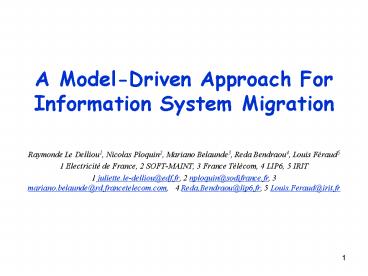A Model-Driven Approach For Information System Migration - PowerPoint PPT Presentation
Title:
A Model-Driven Approach For Information System Migration
Description:
The TRAMs project (2002-2003) RM-ODP Standard as an Intermediate Metamodel (IMM) ... TRAMs framework and methodology have. Improved existing migration tools and ... – PowerPoint PPT presentation
Number of Views:28
Avg rating:3.0/5.0
Title: A Model-Driven Approach For Information System Migration
1
A Model-Driven Approach For Information System
Migration
- Raymonde Le Delliou1, Nicolas Ploquin2, Mariano
Belaunde3, Reda Bendraou4, Louis Féraud5 - 1 Electricité de France, 2 SOFT-MAINT, 3 France
Télécom, 4 LIP6, 5 IRIT - 1 juliette.le-delliou_at_edf.fr, 2
nploquin_at_sodifrance.fr, 3 mariano.belaunde_at_rd.fran
cetelecom.com, 4 Reda.Bendraou_at_lip6.fr, 5
Louis.Feraud_at_irit.fr
2
Outline
- The TRAMs project (2002-2003)
- RM-ODP Standard as an Intermediate Metamodel
(IMM) - The COBOL to JAVA Demonstrator
- Coupling RM-ODP and Action Semantics standards
- Conclusion and further works
3
Aims
- Define a methodology
- Provide an open and modular migration framework
- In order to
- Insure IS migrations in a cost effective manner
- Experiment metamodels and model transformation
techniques
4
TRAMs a methodology and a Framework
- The preparing migration phase
- Identify the migration nature (business or
technologic) - Identify the Metamodels to be used
- Model the migration process (eg. in SPEM)
- Specify the transformation components
- The execution phase
- Monitored by a management component
- Insured by several tools and components
- Includes the execution of manual
actions/interactions
5
The TRAMs generic migration-process
Intermediate Metamodel based on RM-ODP
Metamodel (A)
Metamodel (B)
Transformation rules IMM-gt(B)
Transformation rules (A) -gt IMM
In Conformity
In Conformity
In Conformity
Model (A)
IM
Model (B)
Transformation engine
Transformation engine
Reverse Modeling
Generation
I.S. improvement/changes
Source (A)
Target (B)
6
Why an Intermediate Metamodel?
- To decrease significantly the number of model
transformers to be developed - To decrease time and cost for further migrations
of the Information System
Migration using an Intermediate Metamodel
Point to point Migration
For n formalisms ? n(n-1) set of
transformation rules
For n formalisms ? Only 2n set of
transformation rules
7
IMM Specification RM-ODP standard
- RM-ODP (Reference Model Open Distributed
Processing) as an Intermediate Metamodel - Why RM-ODP?
- - Generic, stable and rigorous concepts
- - Concern separation based System Specification
the Viewpoints (Enterprise, Information,
Computational, Engineering et Technology) - - Used in several domains.
8
The COBOL to Java Demonstrator
- Migration of a sample of an insurance company
application - Focusing on the user interface with limited
business features - Choice of RM-ODP Computational Viewpoint as an
Intermediate Model
Transformation engine
Transformation engine
9
The ODP Computational viewpoint
The Computational Viewpoint Metamodel
10
UML Action Semantics standard
- Action Semantics an extension to UML
- Allows a precise specification of the behavior
- Comes in form of a package Actions
11
The Action Foundation package
- The Action Foundation package the core of Action
Semantics
12
RM-ODP vs Action Semantics
RM-ODP
Action Semantics
well founded semantics
Stability
A precise behavior specification
Rigor
Links between viewpoints
Comes in the scope of the MDA
A complete intermediate MM
13
Integrating the two standards
Action Semantics
14
The final COBOL to Java Demonstrator
- An optimized migration with precise rules
15
Conclusion and further works
- TRAMs framework and methodology have
- Improved existing migration tools and best
practices - Influenced OpenQVT
- TRAMs Intermediate MM
- Concrete semantics not needed
- Good complementarity of the two standards
- Still to come
- Improve code analysis
- Extend the business aspects in the migration

